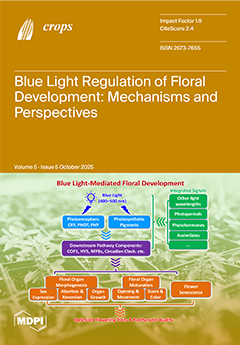Salinity is a major limitation on common bean productivity, while phosphorus in many soils is often immobilized, limiting its availability to plants. This study investigated the effects of coated and uncoated superphosphate fertilizers, applied at different rates and using distinct methods, on soil
[...] Read more.
Salinity is a major limitation on common bean productivity, while phosphorus in many soils is often immobilized, limiting its availability to plants. This study investigated the effects of coated and uncoated superphosphate fertilizers, applied at different rates and using distinct methods, on soil properties, plant growth, and ion regulation in common beans grown in saline soil over two seasons (2023–2024). Treatments combined two fertilizer types (coated with potassium sulfate and uncoated), two P rates (360 and 480 kg/ha), and two application methods: (1) conventional application, broadcasting followed by plowing to 30 cm depth during soil preparation; (2) surface application, broadcasting without incorporation. Six treatments were applied: T
1: 360 kg/ha of uncoated superphosphate (conventional method); T
2: 480 kg/ha of uncoated superphosphate (conventional method); T
3: 360 kg/ha of coated superphosphate (conventional method); T
4: 480 kg/ha of coated superphosphate (conventional method); T
5: 360 kg/ha of coated superphosphate (surface method); and T
6: 480 kg/ha of coated superphosphate (surface method). The results demonstrated that soil pH was unaffected across treatments. However, T
4 and T
6 significantly improved nutrient availability (N, P, and K), biomass, grain yield, and seed nutritional quality (protein, P, K, and Ca). Despite increased soil EC, these treatments enhanced ionic balance (higher K/Na and Ca/Na ratios) indicating improved stress tolerance. Importantly, T
3 (360 kg/ha coated) performed comparably to T
2 (480 kg/ha uncoated), suggesting that coated superphosphate at lower rates can reduce input costs without compromising yield. These results demonstrate the agronomic and environmental benefits of coated superphosphate, particularly under saline conditions, through enhanced nutrient use efficiency and improved crop performance.
Full article





